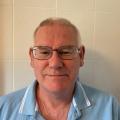A wreath has been laid by armed forces veterans in memory of six British and Canadian airmen who died when their Halifax bomber crashed in Bradford on Avon during a night-time training flight 80 years ago.
Julian Derrick, founder of the recently-formed Bradford on Avon HM Forces Veterans group, laid a wreath at the memorial in Westbury Gardens, on Tuesday evening (March 26).
The ceremony was held 80 years to the day when the Royal Canadian Air Force Handley Page Halifax bomber crashed in flames in Bradford on Avon on March 26 1944.

It was organised by James Crawford, the Royal British Legion Poppy Appeal co-ordinator for Bradford on Avon and Mr Derrick, of Derrick’s Digital Aerials.
Mr Derrick said: “It was a very poignant moment remembering those who gave their lives for our futures.”
On Thursday evening, Bradford on Avon military historian and author, Jonathan Falconer, will give a talk about the crash at St Margaret’s Hall in Bradford on Avon.
He wrote a book four years ago recounting what happened when the night-time cross-country flying training exercise ended in tragedy.

Mr Falconer, of Downs View, a former pupil of Fitzmaurice Grammar School, said: “The incident came within a hair’s breadth of devastating large areas of the town.”
Only two of the eight-strong crew of the Handley Page Halifax bomber, called for V for Victor, of 425 (Alouette) Squadron from Tholthorpe in North Yorkshire, survived the crash at 8.50pm on March 26, 1944.
Three men escaped by parachute before the bomber reached Bradford on Avon, landing at Rudge, Clivey near Dilton Marsh and Westbury, but only two survived.
They were Craig Reid, who had just changed crew positions inside the aircraft to the wireless operator’s seat, and the gunner Bill Cameron.
Bill Cameron returned to flying duties and was promoted to flight sergeant, only to be lost on operations over Germany a few months later on July 18–19 when his Halifax was blown apart by flak over the Ruhr valley. He is buried with his crew at Rheinberg War Cemetery, near Krefeld.
Craig Reid survived the war. He went to university, married and raised a family, and went on to enjoy a career as a social reformer and politician in his hometown of Calgary, Alberta, Canada.
Mr Reid accepted an invitation in 1994 to unveil a memorial at Westbury Gardens in Bradford on Avon to the men who lost their lives in the tragedy.
He travelled to the UK with his wife Verna as special guests of the town and was later reunited with Len Pickett, who rescued him when he was injured during his parachute drop.

Two airmen died after taking to their parachutes when they were too low for them to open properly. Three men died inside the bomber when it hit the ground at what is now Priory Close.
One of them was the pilot Brian Hall who had the chance to bale out but heroically stayed in the cockpit to crash land the aircraft on open ground, thus missing the houses higher up the hill, where an uncontrolled crash landing would have resulted in a great loss of civilian life.
The crew killed in the crash were Flight Sergeants Brian Hall, 22, and Roy Porter, 21, as well as Pilot Officer Don Grover, 23, and Sergeants Harry Newton 22, Norman Simpson, 20, and Graham Evans, 21.
The bodies of the three Canadians, Brian Hall, Don Grover and Roy Porter, were buried in Haycombe Cemetery in Bath. The bodies of the three British crew members were returned to their families for burial.








Comments: Our rules
We want our comments to be a lively and valuable part of our community - a place where readers can debate and engage with the most important local issues. The ability to comment on our stories is a privilege, not a right, however, and that privilege may be withdrawn if it is abused or misused.
Please report any comments that break our rules.
Read the rules here